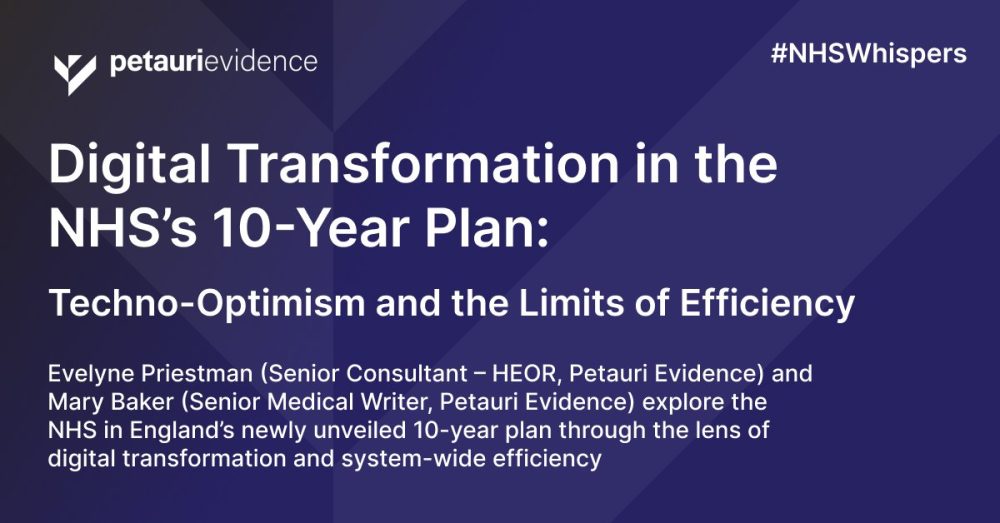Digital Transformation in the NHS’s 10-Year Plan: Techno-Optimism and the Limits of Efficiency

Here, Evelyne Priestman (Senior Consultant – HEOR) and Mary Baker (Senior Medical Writer) at Petauri Evidence explore the National Health Service (NHS) in England’s newly unveiled 10-year plan through the lens of digital transformation and system-wide efficiency. This article examines the implications for Medtech and Pharma, highlighting what market access teams may need to consider as the NHS redefines how it delivers and evaluates care.
A Bold Bet on Technology
England’s NHS has unveiled its latest 10-year plan (1). Once again, the world’s most famous tax-funded health system has positioned technology as a crucial tool for addressing both current and future challenges, alongside community and prevention. The clinical priorities of its 2019 plan (cancer, cardiovascular disease, and diabetes, among others) have taken a step back, as prevention, partly facilitated by technology, becomes the goal. The new plan emphasises artificial intelligence (AI) and digital tools, the latter of which is intended to feature heavily in the strategy to shift care from hospitals to the community.
On paper, the plan is a hymn to efficiency. AI, data, genomics, wearables, and robotics will triage patients, enhance diagnostics, and streamline inefficient care pathways. Administrative tools will automate burdensome paperwork; even scribing duties will be delegated to algorithms. There is talk of fully AI-enabled hospitals within the decade. The NHS app, meanwhile, is to morph into a personal health assistant, integrating genomic data, electronic records, and wearables. Patients will self-refer and manage their care via their phones.
Other proposals are more pragmatic. ‘Year of care payments’ (YCPs) promise to align budgets across care pathways with the aim of optimising service delivery, prioritising patient preferences, and consolidating care provision to offer long-term clinical and economic benefits. The plan also puts National Institute for Health and Care Excellence (NICE)’s ability to withdraw approval for treatments as newer, more cost-effective ones emerge, in the spotlight as a key part of the solution.
Digital Gains, Delivery Gaps
Faster detection via AI and other scientific advancements may help with earlier diagnosis. Yet, without corresponding investment in the ability to treat (whether through increased or restructured labour or more dynamic approaches to treatment facilities and locations), these tech-enabled diagnoses risk compounding existing bottlenecks, rather than relieving them. Early detection without timely treatment deepens the pressure on an already overburdened system.
Similarly, early identification of prognostic risk factors via genomics and AI-driven data analysis, based on an individual’s likelihood of disease development, will only be truly useful when paired with robust preventative solutions. These could include both patient-led efforts, such as lifestyle changes, and clinically provided interventions, whether pharmacological or surgical, that can halt or significantly delay disease progression.
The Limits of Tech-Driven Reform
It is vital that the other two areas of focus in the NHS plan, community care and disease prevention, are achieved without solely relying on technology. Whilst AI has the potential for paradigm change across multiple areas, it is not the only answer. Many in our industry agree that AI can only drive change if it is properly implemented by the NHS, and understood and adopted by clinicians (2).
Clearly there are areas where technology can only boost the NHS (such as greater integration of care systems in a digital form) but, for all its techno-optimism, the plan potentially sidesteps structural realities. The NHS’s capacity crisis is not purely logistical; it is one of labour and the public’s acceptance of change. The ‘cradle-to-grave’ intentioned NHS, which has arguably become focused more on episodic ‘sickness care’, is now straining under an ageing, chronically ill population.
Balancing Technology and Workforce
Though the NHS’s digitisation drive will surely yield some efficiency gains, particularly in administrative tasks and routine diagnostics, healthcare remains fundamentally labour intensive. No AI tool or app can replace the need for skilled clinicians, timely care, or physical infrastructure.
England’s ambitions are bold in some respects – particularly those related to AI – but also fragile. There is a pledge to cut international recruitment, an ethical as much as practical dilemma, to under 10% by 2035. Yet this ignores NHS England’s own admission last year that domestic training would need to expand by at least 50% to fill current shortfalls (3). A separate workforce plan, due later this year, is supposed to resolve this tension.
How the NHS 10-Year Plan Compares With Global Digital Health Strategies
Other nations have shown how digitisation can support more seamless care. For example, Denmark has one of the most digital-backed healthcare systems globally. The Danish digital system began with digital hospital records in 1995, and has subsequently grown, rooted in a foundation of collaboration from local to central governance (4). Denmark’s ‘Sundhed.dk’ portal allows citizens to book appointments, view records, and communicate with doctors; achievements the NHS app aspires to match (5). Yet this technological innovation is paired with sustained investment in workforce and infrastructure.
Implications for Medtech and Pharma: What Market Access Teams Need to Know
For Medtech and Pharma companies, the NHS’s 10-year plan signals a shift in how value can be defined, delivered, and assessed. The emphasis on digital tools, AI, and integrated care pathways requires more adaptive, digitally fluent approaches to stakeholder engagement and service delivery. In a changing environment shaped by digital transformation, market access teams will need to be agile, anticipating how these shifts influence implementation, evidence generation, and stakeholder expectations.
So what does this mean in practice?
- Value propositions must evolve: Whilst demonstrating clinical efficacy remains essential, products and services will also need to show how they contribute to system-wide efficiency, support digital workflows, and align with population health goals
- Engagement strategies must shift: With care moving into the community and digital platforms, like the NHS app, becoming central to patient interaction, companies must consider new touchpoints for engagement – both with clinicians and patients
- Evidence generation is ongoing: Whilst NICE already has mechanisms to revisit guidance, the plan’s suggestion of withdrawing support for interventions that are no longer cost effective raises important questions. In this context, real-world evidence and health economic data may play an increasingly important role across the product lifecycle. Presently, greater clarity is needed on how interventions for withdrawal will be identified
- Digital readiness is essential: Solutions that integrate seamlessly with NHS digital infrastructure, or enhance it, will have a competitive edge. Interoperability, data security, and usability will be key differentiators
Key questions for market access teams to consider:
- How does our offering support the NHS’s goals around digitisation and efficiency?
- Can we demonstrate value across the entire care pathway, not just at the point of intervention?
- How will the 10-year plan impact the health technology assessment (HTA) process in England?
- How can we align our engagement strategies with the NHS’s evolving digital front door?
The NHS’s 10-year plan is not just a roadmap for internal reform, it’s a signal to the wider health ecosystem. For Medtech and Pharma, those who adapt early and align closely with these priorities will be best positioned to thrive in the NHS of the future.
Do you have thoughts, hopes, or concerns now that you’ve read the NHS’s new 10-year plan? Explore this further with the Petauri Evidence team, email evidence@petauri.com.
References
1. NHS England. Fit for the future: 10-year health plan for England. 2025. Available from: https://www.gov.uk/government/publications/10-year-health-plan-for-england-fit-for-the-future Accessed: July 2025
2. Strain WD, Cronin-Lampe J, Evans M, Mitchell C, Padgett T, McEwan P. NHS 10 year plan: Can using AI offer a solution to the NHS’ problems? BMJ. 2025;390:r1407.
3. NHS England. NHS Long Term Workforce Plan. 2024. Available from: https://www.england.nhs.uk/long-read/nhs-long-term-workforce-plan-2/#2-train-growing-the-workforce. Accessed: July 2025.
4. Healthcare Denmark. Digitalisation in Danish healthcare. 2024. Avaiable from: https://healthcaredenmark.dk/news-publications/publications/digitalisation-in-danish-healthcare/. Accessed July 2025
5. Sundhed.dk. Sundhed.dk – background. 2023. Available from: https://www.sundhed.dk/borger/service/om-sundheddk/om-organisationen/ehealth-in-denmark/background/. Accessed: July 2025.

Share